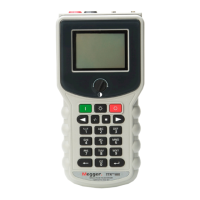SETUP AND CONNECTIONS
AVTMTTR100-ENG Rev 6 Nov 2015
21
Current Transformers (CTs)
Connections to CTs are made backwards compared to power, distribution or
potential transformers. The H terminals on the test set must be connected to the
X terminals on the CT; and the X terminals on the test set must be connected to
the H terminals on the CT.
NOTE: Dots on the housing of the transformer are commonly used to identify
terminals of the same polarity.
F
WARNING
Failure to observe proper connections will result in a safety hazard and
may result in damage to the test set or CT. Failure to observe voltage
rating of low-current X winding may result in damage to the CT.
NOTE: The TTR100 may supply up to 100 mA of excitation current. The TTR100
will automatically select the appropriate test voltage (8 V or 1.5 V) when testing
CTs. Some current transformers with turn ratio of 150:5 and less requires more
than 100 mA of excitation current when excited from 1.5 V source. These CTs
cannot be tested with the TTR100.
Unmounted CTs
The connection instructions of the TTR100 to the device to be tested are
contained and illustrated within the TTR100.
NOTE: The illustrated connection diagrams are provided as connection guides
and do not suggest the physical location of the bushings / terminals of the device
being tested.
Figure 5-5 shows the setup for testing unmounted current transformers. Figure 5-
6 shows the setup for testing the taps on a multiple-tap CT.
Bushing Current Transformer (BCT) Mounted on Single-Phase, Two-
Winding Transformer
A turn-ratio test can be performed on a BCT after it has been mounted on a
circuit breaker or power transformer entrance bushing. The test can be
performed without removal of the BCT from the equipment. Connect the TTR100
to BCT as shown in Figure 5-7.
NOTE: A jumper lead is not supplied with the TTR100.

